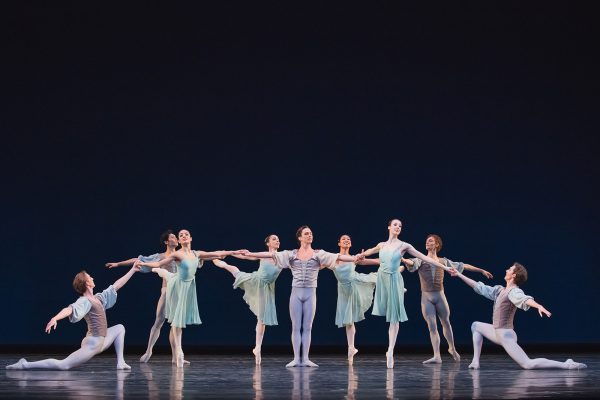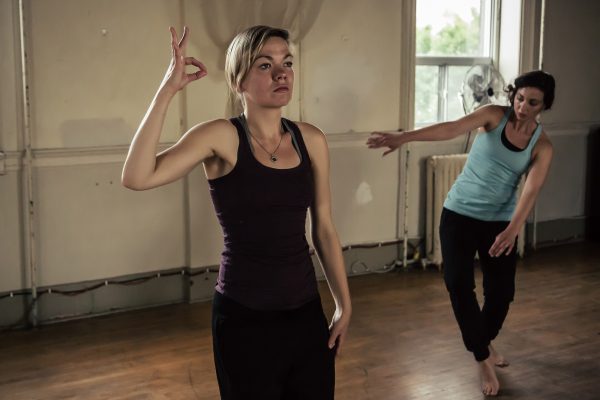From the periphery, even familiar partnerships are perceived only partially. Their intimate cadences are furtively indiscernible. Karen and Allen Kaeja’s presence in the dance community brings a certain level of recognition that creates a sense of ease; although their work is diverse, I know what to expect from their presence as performers. Their most recent production, lifeDUETs, a celebration of twenty-five years of life and work together, shares these intimate cadences with us. But the comfortable ease we are used to seeing from Karen and Allen on stage is largely absent in these two new works.
Featuring choreography by Benjamin Kamino and Tedd Robinson, the program is a meditation on how the emotional polarities of a long-term partnership are, in fact, not oppositional but cut from the same cloth. In turn, the evening prompts a reflection on relationships as entities with their own sets of rhythms. The tempos mutually conveyed by the Kaejas reverberate through the theatre. Each work leaves us with the resonant pulses of their partnership.
Both of these works feel at least partially autobiographical. In Kamino’s with, turbulent and tender moments feel personal, and I can’t help but feel intrusive witnessing them. This tone is established even before the dance begins; the stage is set when the audience enters, with the dancers in position. Karen, in Allen’s embrace, lies with her head on his lap. There is a sense of entering a moment in progress. They remind me of a living Michelangelo sculpture, and the baroque choral music by Antonio Lotti gives the theatre an elegiac atmosphere as we settle into our seats. The stage floor is covered by large pieces of white roll paper, which serves as both set and prop and gives the dark theatre a sense of levity.
Once moving, the dancers maintain and break eye contact throughout. When they break their gaze from each other, a connection is still palpable, as though they are tied together with invisible energy. Their merging feels part of their very DNA — reverberating at the cellular level. At times with feels intentionally disorderly. Movement textures, as they relate to emotion, are the investigation of this work and they vary between confrontational and loving, with many shadings in between. The complexities of long-term relationships are its subject. Adoration quickly turns to condemnation, indifference to curiosity, giving the impression that these qualities coexist in a mutual dependency.
The choral music is interrupted by silences throughout, and during the quiet moments there is an extra inadvertent soundtrack — the frenzied soundtrack of Blue Jays revellers on Queen Street outside. Amidst the honking horns and chanting, the unpredictability of live performance — the here and now — becomes ever more apparent. From inside the theatre the revellers sound ominous, more like a lynch mob than a celebration. This din from beyond the theatre walls creates yet another instance of emotional extremes as easily reversible into their opposites.
Goofier moments expressed by Karen and Allen are not maudlin; rather, we are witness to their private jokes. We see them seeing each other at their most awkward, most amorous and most disagreeable. They acknowledge these qualities in each other and accept it, and I do too, but not without feeling slightly awkward.
In perhaps the most arresting moment of the work, Allen lifts up a back corner of the paper floor, altering the landscape of the stage by creating a vertical plane. With this paper massif as her backdrop, Karen dances a captivating solo in which the audience, at last, sees the virtuosity we are accustomed to when watching her dance. Her movement is fluid and easy even when she is gyrating her hips or convulsing in heaves. Dancing without the gaze of Allen (he’s still under the paper), she gains a sense of freedom.
lifeDUETs exists in two “time zones” of current and nostalgic aesthetics. Its two premiere works, while dwelling in memory, also bring to my mind issues of how we classify what is aesthetically “new” in contemporary dance and, more importantly, whether this classification is even a worthwhile exercise. In a keynote speech on October 14 at the Postdance Conference in Stockholm, British choreographer Jonathan Burrows discussed the categorization of dance in this way as integral to the mythology of modern dance and its proclamations of perpetual innovation. In being preoccupied with “newness”, he suggests, “We forget we have this thing called a body, which hasn’t changed much in the past 150,000 years […] everything is new at the point of performance if you want it to be.” Certainly disparities in corporeality can imprint on dancers of a generation, but, in focusing on difference, are we forgetting about the shared experience of living within a human body? In asking us to “cherish the past,” Burrows seems to echo the ethos of this show — that the familiar can be celebrated instead of dismissed as passé.
Burrow’s remarks resonate with me as I watch the second work of the evening, Robinson’s 25 to 1, in which the dancers seem to revisit familiar personal memories. The movement aesthetic references their past training, which is rooted in contact improvisation. The dancers enter the space, strolling, flirting and smiling. They appear as young lovers. Eventually, Karen puts her fingers to Allen’s mouth to quiet him, and they share a passionate kiss. As the work progresses, they set up a tent on the stage, and the significance of this is revealed near the conclusion of the dance when the dancers, fully zipped inside their tent, create a shadow dance, reminding us again of the partial glimpses of a relationship we are privy to as the audience.
The original score, composed by Charles Quevillon, features strings and soaring vocals, which echo the choral music of the previous piece. The lyrics engage us in the complicated emotional extremes of partnership. The voice croons, “I want you, I need you,” “I hate you, I never loved you,” and finally, “I’m so confused,” and it is both comical and sincere. This accompaniment to the Kaeja’s recovered and re-enacted memories is enhanced by fog in the background, perhaps signifying a campfire. It is present and intangible — a ghostly recollection itself.
In perhaps the most overtly autobiographical moment of the work, the dancers count backwards from twenty-five while dancing a partnering sequence from inside the tent. Each number reads as a vignette with the dancers briefly pausing in a position. It seems a summary of their years together as artists and partners. The tent is at times a shelter that protects them, and at others a cage containing their struggles. They work together and against each other. In a moment of stillness they pause to look out beyond the tent door. Their gaze frames the audience, and Karen and Allen invite our gaze to partake in their fragile and joyous moments. I am left with the impressions of this partnership and their effortless partnering after a quarter-decade of dancing and living together.
Tagged: Choreography, Contemporary, Performance, ON , Toronto




